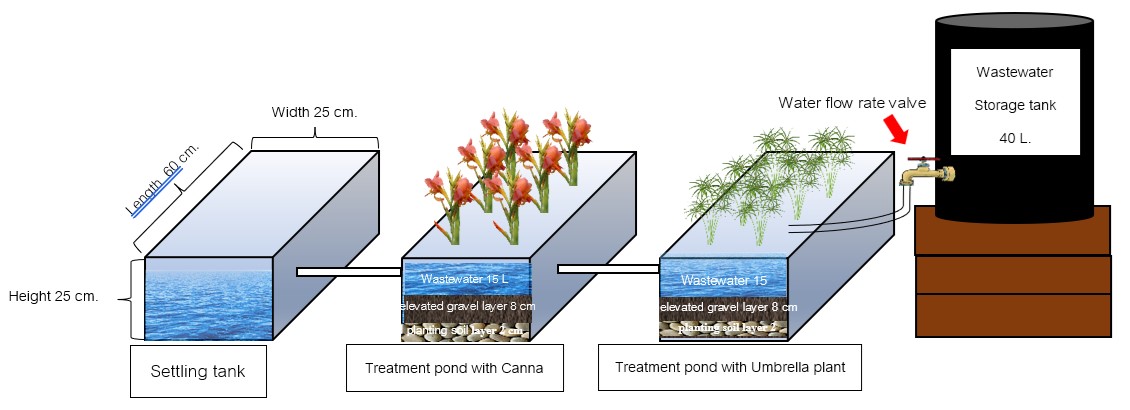Effects of pH Adjustment in Wastewater on the Efficiency of Local Aquatic Plants in Treating Wastewater from a Household-Scale Rice Noodle (Khanom Jeen) Factory
Keywords:
pH adjustment , wastewater from Khanom Jeen factory , local aquatic plantsAbstract
Background and Objectives : The wastewater generated from a Khanom Jeen (fermented rice noodles) factory is characterized by its turbid milky white appearance and sour odor, which results from the presence of organic matter derived from the fermentation of starch during noodle processing. As a result, this wastewater exhibits high acidity, with a pH ranging from 3.25 to 3.56, that affect human health including environmental problems. Therefore, the objectives of this study were to investigate the effects of pH adjustment and non-adjustment on the efficiency of three locally available aquatic plants, i.e. water hyacinth, umbrella plant, and canna- in treating wastewater from Khanom Jeen production. The ultimate goal is to explore an effective and cost-efficient wastewater treatment system suitable for household-scale implementation, thereby promoting sustainable wastewater management practices.
Methodology : The study was conducted using experimental wastewater treatment ponds constructed from cement tanks with dimensions of 25 cm in width, 25 cm in height, and 60 cm in length. Each ponds was filled with gravel and planting soil. The plants were pre-cultivated to ensure root stabilization and new shoot (sprout) growth before employing in the experiments. Features of each plant type, i.e., size, height, stem, and 50 cm root length approximately, and 0.5 kg (wet basis) each were considered. The study was divided into two experimental setups. In the first setup, the wastewater pH was adjusted to neutral condition (pH 7) by using lime (Cao), and compared with untreated acidic wastewater. This setup consisting of four treatments, i.e., a control pond (no plant cultivation), a pond with water hyacinth, a pond with umbrella plant, and a pond with canna. Each treatment contained 10 liters of wastewater, and the periods retained at 3, 5, and 7 days. As for the second set, the experiment of a sequential wastewater treatment system was utilized with different aquatic plant species in each treatment, comprising a wastewater holding tank, a pond with umbrella plant, a pond with canna, and a final effluent storage pond. The system was operated continuously for 15 days, treating 20 liters per day of wastewater at a flow rate of 14 mL/min and a retention time of 24 hours per pond. Sampling of influent and effluent wastewater were collected, and were analyzed of key water quality parameters, including pH, total suspended solids (TSS), biochemical oxygen demand (BOD), chemical oxygen demand (COD), total nitrogen (TN), and phosphate (PO₄³⁻). Mean values, standard deviation, and F-test (One-way Anova Analysis) comparisons were statistics for analysis. The mean difference of plant remediation efficiency in wastewater treatment conditions was compared by using Least Significant Difference (LSD) at a 0.05 significance level.
Results : For the first experimental set, found that the three local aquatic plant species, i.e. water hyacinth, umbrella plant, and canna were demonstrated significant efficiency in reducing total suspended solids, biochemical oxygen demand, and phosphate across the three retention periods (3, 5, and 7 days). In the pH-adjusted condition, removal efficiencies ranged from 88.66% to 97.34% for TSS, 72.33% to 85.47% for BOD, and 6.23% to 35.48% for phosphate. In the non-adjusted condition, the corresponding removal efficiencies were 82.40% to 96.62% for TSS, 74.31% to 85.47% for BOD, and 8.90% to 69.41% for phosphate. Among the three species, umbrella plant exhibited the highest treatment efficiency under both conditions, with average efficiencies of 66.78% (pH-adjusted) and 71.63% (non-adjusted). A significant difference (p<0.05) in treatment efficiency was observed between pH-adjusted and non-adjusted conditions, with all plant species performing significantly better than the control (no plants). In the second setup, daily variations influent water quality were observed. As wastewater passed through the plant-based treatment system, all measured parameters showed a reduction except for pH, which increased. The treatment efficiencies for TSS, BOD, COD, total nitrogen, and phosphate were 86.96%, 57.33%, 76.24%, 48.98%, and 24.04%, respectively. The system achieved removal efficiencies of 86.96% for SS, 57.33% for BOD, 76.24% for COD, 48.98% for TN, and 24.04% for phosphate.
Conclusions: This study demonstrates the potential of utilizing locally available aquatic plant species, particularly umbrella plant and canna, for effective wastewater treatment. These plants significantly reduced total suspended solids, organic pollutants, including BOD, COD, total nitrogen, and phosphate concentrations in wastewater from a Khanom Jeen factory. Furthermore, a notable increase in pH was observed after treatment in all experiments, suggesting an improvement in wastewater acidity. The initial pH of the influent ranged from 2.93 to 3.31, with an average of 3.05, whereas the treated effluent had an increased pH range of 3.44 to 4.80, with an average of 3.99. The use of these plant species in a low-cost, sustainable treatment system offers a viable solution for managing acidic wastewater in small-scale and household settings, thereby contributing to improved environmental and public health outcomes. Future research should explore long-term performance, the potential for nutrient recovery, and the feasibility of scaling up this treatment approach for larger wastewater volumes.
References
Aiamsaart, P., & Naka, S. (2021). Wastewater Treatment from the Noodles (Khanom Jeen) Flour Factory by Anaerobic Filter Tanks System with Floating Plants (Bachelor's thesis, Environmental Science). Maha Sarakham : Rajabhat Maha Sarakham University. (in Thai)
Ariyakanon, N. (2018). Water hyacinth and treatment of pollutants in water. Environmental Journal, 22(3), 49-55. (in Thai)
Boonprot, S. (2014). Treatment of Thai Fermented Rice Noodle Factory Wastewater by Limestone Equalization and Natural Treatment Systems. (Master's thesis, Environmental Science). Bangkok: Kasetsart University. (in Thai)
Department of Industrial Works. (2009). Principles of clean production technology (enhancing production efficiency and pollution prevention) in the rice noodle flour industry (1st ed.). Bangkok: Department of Industrial Works. (in Thai)
Klamjek, P. (2009). Role of wetland plants for wastewater treatment. Khon Kaen Agriculture Journal, 37(1), 79-86. (in Thai)
Muleng, S., & Jijai, S. (2019). Effect of Thai rice noodle wastewater with rice husk and dung to bio-fertilizer production (Research report). Yala: Yala Rajabhat University. (in Thai)
Pladprom, S., & Yongmanee, S. (2015). Performance analysis of Limnocharis flava (L.) Buchenau and Canna indica L. to TKN removal efficacy of effluent wastewater from Fort Suranaree Hospital, Nakhon Ratchasima. In Proceedings of the 2nd National Research Conference on "Creativity and Development towards ASEAN Community" (pp. 128-134). Nakhon Ratchasima: Nakhon Ratchasima College. (in Thai)
Pollution Control Department. (2012). Wastewater management manual for households. Bangkok: Community Wastewater Division, Water Quality Management Bureau. (1st ed.). Bangkok: Pollution Control Department (in Thai)
Pratum, C. (2016). Influence of High Organic Substances Concentrations in Fermented Rice Noodle (Khanomjeen) Factory Wastewater on Efficiency Wastewater Treatment of Vetiveria Zizanioides Nash. and Cyperus Corymbosus Rottb. Journal of Science and Technology Mahasarakham University, 36(3), 324-332. (in Thai)
Rattanapan, W. (2007). Treatment Condition of Wastewater from Thai Rice Noodle Production. (Master's thesis, Environmental Engineering). Bangkok: Kasetsart University. (in Thai)
Sawain, A., Kaipittayakorn, W.,& Sujarit, C. (2016). Modified Anaerobic Baffled Reactor (MABR) Approach and Multi Criteria Decision Analysis (MCDA) for Utilization Wastewater Treatment in Fermented Rice Noodle Factory (Research report). Songkhla: Rajamangala University of Technology Srivijaya,Trang Campus.(in Thai)
Somprasert, S., Nilratnisakorn, S., Sarnpra, P.,& Podam, S. (2016). Efficiencies of Constructed Wetland Systems Using Native Plants for Treatment of Strong Acidity Wastewater. Environmental Engineering Journal, 30(1), 49-57.
Sonraksa, P.,& Changchansri, S. (2022). Effect of pH Condition Adjustment in wastewater from the Noodles (Khanom Jeen) Flour Factory on Treatment Efficiency of Aquatic Plants (Bachelor's thesis, Environmental Science). Maha Sarakham: Faculty of Science and Technology, Rajabhat Maha Sarakham University. (in Thai)

Downloads
Published
How to Cite
Issue
Section
License
Copyright (c) 2025 Faculty of Science, Burapha University

This work is licensed under a Creative Commons Attribution-NonCommercial-NoDerivatives 4.0 International License.
Burapha Science Journal is licensed under a Creative Commons Attribution-NonCommercial-NoDerivatives 4.0 International (CC BY-NC-ND 4.0) licence, unless otherwise stated. Please read our Policies page for more information



